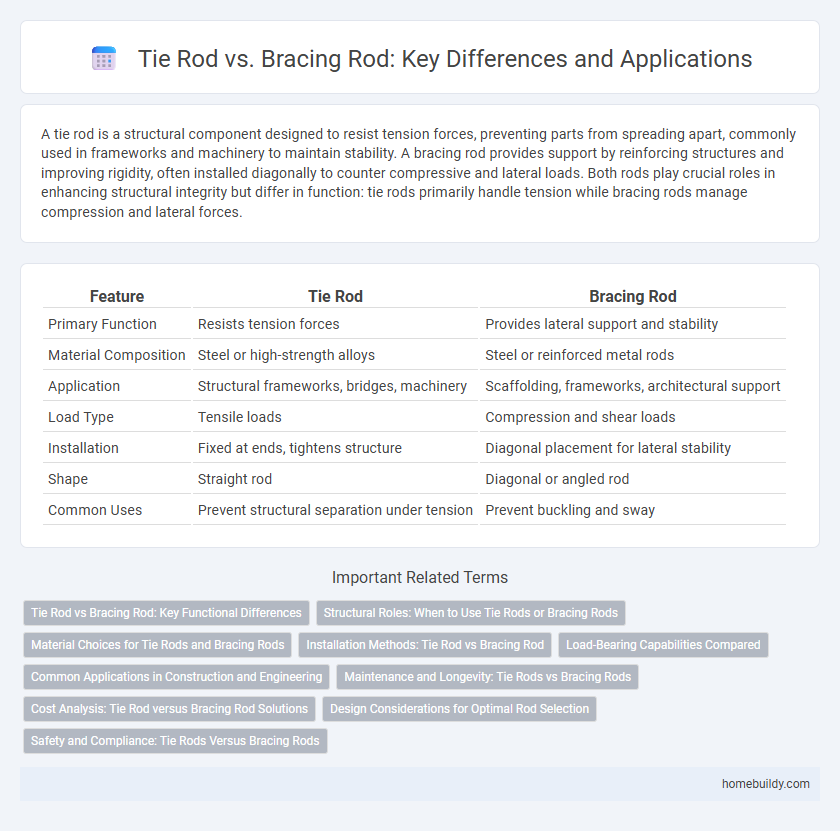A tie rod is a structural component designed to resist tension forces, preventing parts from spreading apart, commonly used in frameworks and machinery to maintain stability. A bracing rod provides support by reinforcing structures and improving rigidity, often installed diagonally to counter compressive and lateral loads. Both rods play crucial roles in enhancing structural integrity but differ in function: tie rods primarily handle tension while bracing rods manage compression and lateral forces.
Table of Comparison
| Feature | Tie Rod | Bracing Rod |
|---|---|---|
| Primary Function | Resists tension forces | Provides lateral support and stability |
| Material Composition | Steel or high-strength alloys | Steel or reinforced metal rods |
| Application | Structural frameworks, bridges, machinery | Scaffolding, frameworks, architectural support |
| Load Type | Tensile loads | Compression and shear loads |
| Installation | Fixed at ends, tightens structure | Diagonal placement for lateral stability |
| Shape | Straight rod | Diagonal or angled rod |
| Common Uses | Prevent structural separation under tension | Prevent buckling and sway |
Tie Rod vs Bracing Rod: Key Functional Differences
Tie rods primarily provide tensile strength by resisting pulling forces in structural frameworks, enhancing stability and load distribution. In contrast, bracing rods resist compressive forces and lateral movement, preventing buckling and maintaining alignment. The key functional difference lies in tie rods counteracting tension, while bracing rods focus on compression and support.
Structural Roles: When to Use Tie Rods or Bracing Rods
Tie rods primarily provide tensile strength to resist pulling forces in a structure, ensuring stability under tension. Bracing rods are designed to counteract compressive and lateral forces, preventing buckling and maintaining rigidity. Use tie rods when tension is dominant, such as in suspension systems, and bracing rods when lateral support and resistance to compression are critical, like in trusses or frames.
Material Choices for Tie Rods and Bracing Rods
Tie rods are commonly manufactured from high-strength steel alloys, such as carbon steel or alloy steel, to provide excellent tensile strength and durability in structural applications. Bracing rods often utilize materials like galvanized steel or stainless steel to resist corrosion and maintain rigidity under lateral loads. Selecting the appropriate material depends on environmental exposure, load requirements, and longevity expectations for tie rods and bracing rods in construction projects.
Installation Methods: Tie Rod vs Bracing Rod
Tie rods are typically installed by anchoring at both ends with bolts or clamps, ensuring tension is applied to stabilize the structure, while bracing rods often use turnbuckles for adjustable tension settings during installation. Installation of tie rods requires precise alignment to maintain structural integrity under load, whereas bracing rods allow for easier field adjustments due to their threaded components. Both methods prioritize secure attachment points, but tie rods demand more rigid, permanent fixtures compared to the flexible installation of bracing rods.
Load-Bearing Capabilities Compared
Tie rods typically offer higher tensile strength and are specifically designed to resist tension forces, making them ideal for load-bearing applications that require structural stability. Bracing rods, while providing lateral support and preventing buckling, generally have lower load-bearing capacity compared to tie rods due to their design focus on compression and stability. The distinct load-bearing capabilities of tie rods versus bracing rods are critical in choosing the appropriate component for engineering structures exposed to varying stress conditions.
Common Applications in Construction and Engineering
Tie rods primarily provide tensile strength in structural applications, often used to resist tension forces in frameworks like bridges, roofs, and retaining walls. Bracing rods serve to stabilize structures by preventing lateral movement and buckling, commonly found in scaffolding, towers, and trusses. Both components are essential in construction and engineering, with tie rods focusing on tension support and bracing rods ensuring overall structural stability.
Maintenance and Longevity: Tie Rods vs Bracing Rods
Tie rods require regular inspection for thread integrity and corrosion to ensure optimal performance, while bracing rods typically demand less frequent maintenance due to their simpler design. The longevity of tie rods often depends on the quality of materials and protective coatings, making them susceptible to wear in harsh environments. Bracing rods generally exhibit longer service life with minimal upkeep when installed in stable structural conditions.
Cost Analysis: Tie Rod versus Bracing Rod Solutions
Tie rods generally offer a more cost-effective solution compared to bracing rods due to lower material and installation expenses. Manufacturing tie rods involves simpler fabrication processes and fewer components, which reduces overall project costs. Furthermore, tie rods provide efficient load transfer with minimal maintenance, enhancing their long-term economic advantages in structural applications.
Design Considerations for Optimal Rod Selection
Tie rods and bracing rods differ significantly in design considerations, where tie rods primarily handle tensile forces to prevent structural separation, while bracing rods resist compressive and bending stresses to enhance stability. Optimal rod selection requires analyzing load types, material strength, and connection details to ensure the rod meets performance criteria without excess weight or cost. Structural engineers must prioritize factors such as maximum allowable deflection, corrosion resistance, and ease of installation to achieve a balance between safety and efficiency.
Safety and Compliance: Tie Rods Versus Bracing Rods
Tie rods provide superior safety and compliance in structural applications by offering adjustable tension control, ensuring precise load distribution and stability. Unlike bracing rods, which primarily resist compression and lateral forces, tie rods are specifically designed to handle tensile stresses, enhancing the overall integrity of frameworks. Compliance with building codes often favors tie rods due to their proven performance in preventing structural deformation and failure.
tie rod vs bracing rod Infographic

 homebuildy.com
homebuildy.com